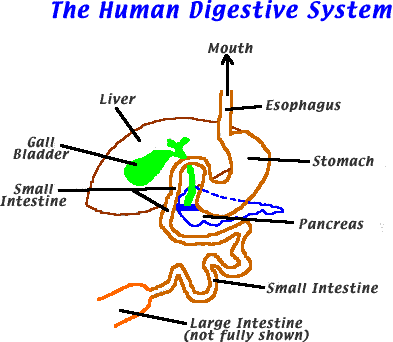 Route of Digestion:
Route of Digestion:Food is:
a. Mechanically broken down (smaller pieces)
b. Chemically broken down into small molecules.
c. The small molecules are absorbed into the blood stream for distribution.
 Route of Digestion:
Route of Digestion:Mechanical breakdown (teeth & tongue). Chemical breakdown via saliva. (Salivary glands release saliva which contains amylase to change starch to simple sugars.) Saliva also moistens & speeds food movement.
Throat. Tongue pushes food into a ball (bolus) & into pharynx. Epiglottis (cartilage flap covering wind pipe) closes to prevent food entering trachea.
Ttansport passage. Muscles force bolus downward (an action called peristalsis). The bolus passes the sphincter (muscle between esophagus and stomach preventing movement back to stomach!)
a. More mucus,
b. HCl (break large molecules ----> small)- Acidic pH
c. Pepsin (break large protein molecules ----> small).
2-3 hours later, food is now a pasty mix called chyme.
Pyloric valve between stomach and small intestine opens.
~21 ft long tube for further digestion.
a. Duodenum: 1st part of S.I.. Glands on S.I. & from pancreas & gall bladder release enzymes to finish all digestion.
b. 2nd part of S.I.: Nutrients absorbed thru villi into blood. Villi are finger-like folds in S.I. wall to increase area where food can be absorbed (diffuse through). (see fig. 34-6)
Undigested food & water move to Large Intestine.
A. Water removed & returned to blood.
B. Peristalsis moves wastes to rectum for storage, until it leaves via the anus.
C. Bacteria in L.I. help finish digestion & produce Vitamin K.
All nutrients in blood first go to the liver, which regulates how much of each nutrient is in the blood. Extra molecules are stored in the liver (except some fats).